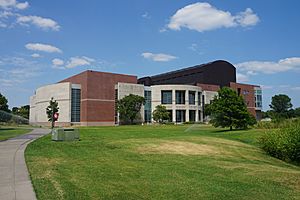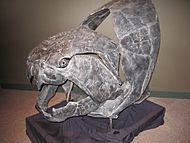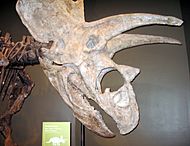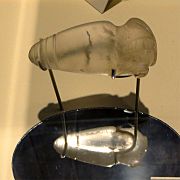Sam Noble Oklahoma Museum of Natural History facts for kids
The Sam Noble Oklahoma Museum of Natural History is the official natural history museum for the State of Oklahoma. It is located at the University of Oklahoma. The museum started in 1899. Its current building opened in 1999. This museum holds over 10 million items. These items are part of 12 different collections. The building is very large. It has almost 50,000 square feet of public space. Here, you can explore five permanent and two temporary exhibits. These exhibits show Oklahoma's natural and cultural history. The rest of the building is for storing collections, labs, libraries, and offices. It is one of the biggest university museums of its kind in the world.
Before 1999, the museum was much smaller. It was in different buildings on campus. It was first called the Department of Geology and Natural History. Later, it became the Museum of the University of Oklahoma in 1943. In 1953, it was named the Stovall Museum of Science and History. This was to honor J. Willis Stovall. He was a paleontologist and professor. He was the director from 1943 to 1953.
Awards and Recognition
The Sam Noble Museum has won many awards. These awards are from both the U.S. and other countries. In 2004, it won a national award. This was for taking good care of its collections. In 2014, it received the National Medal for Museums. This is the highest award for a museum from the U.S. government. It was given because the museum helps people, families, and communities. First Lady Michelle Obama presented this award at the White House.
In 2015, the museum won an award in Croatia. This was for being one of the best international heritage projects. In 2017, it won an award in Finland. This was from the International Council of Museums. It recognized the museum's program for Native American youth languages.
History
The University of Oklahoma started in 1890. About 10 years later, the Oklahoma Territorial Legislature wanted a museum there. In 1899, they passed a law. This law created a territorial geologist position. It also said that collections would be gathered from the geologist's work. The law also started a Department of Geology and Natural History. This department would study Oklahoma's natural resources. This included plants, animals, and minerals.
As the university's collections grew, people tried to build a museum. This was in the early 1900s. In 1920, they almost succeeded. The university sent an expedition to Alaska. They collected large North American animals. These included grizzly bears and caribou. They hoped these animals would make Oklahomans want to fund a new museum. The animals are still studied today. But the governor stopped the museum funding bill at that time.
The museum collections kept growing. This was even during the Great Depression and Dust Bowl. President Franklin Roosevelt started the Works Progress Administration (WPA). This program created jobs during the Great Depression. About 50 workers were assigned to museum paleontologist J. Willis Stovall. These workers helped dig up dinosaur fossils across Oklahoma. They found many large and unique dinosaur and mammal fossils. The museum's fossil collection grew quickly. It also needed more storage space.
At the same time, university archaeologists led digs. These were in eastern Oklahoma. Large teams of WPA workers helped them. A famous dig was at Spiro Mounds. This was an important Native American site. It was used mostly from AD 1000 to 1400. The WPA digs helped us understand Oklahoma's Native American history. They found many cultural items. These items became the start of the museum's archaeology collection.
J. Willis Stovall wanted to bring all the university's collections together. In the late 1930s, Stovall became the director of this early museum. Its collections were spread out in many university buildings. Stovall tried many times to get money for a dedicated museum building. But he could not before he passed away in 1953. Even though the collections were still spread out, Stovall helped unite them. He also got some storage space for many items.
By 1980, the museum collections were in 10 different buildings. These buildings were often not good for preserving items. They included a horse stable and old army barracks. The main museum building was an armory. It was built in the 1930s for the ROTC. This building was later named the Stovall Museum of Science and History. This was after J. Willis Stovall passed away.
In 1983, Michael Mares became the museum director. The Stovall Museum started a campaign. They wanted Oklahomans to know how important their natural and cultural treasures were. They also wanted people to know about the poor storage conditions. Over several years, Mares and museum staff shared this message. They talked to state representatives and senators. They worked to create a new state law. This law would recognize the Stovall Museum as a state resource. In 1987, the Oklahoma Legislature approved a law. This law made the Stovall Museum the official Oklahoma Museum of Natural History.
In the early 1990s, people in Norman, Oklahoma, wanted a new museum. They wanted a better place for the state's collections. In 1992, they held a special election. The citizens of Norman promised $5 million for a new museum. This was if the state and private donors raised $30 million. A statewide election passed. This secured Oklahoma's $15 million commitment. Soon after, the Samuel Roberts Noble Foundation donated $10 million. This donation helped name the museum. It became the Sam Noble Oklahoma Museum of Natural History. Other donors also helped raise the rest of the money.
Construction for the new museum began in 1996. The new museum building officially opened to the public in May 2000.
Permanent Exhibits
Orientation Gallery
The Orientation Gallery is the first exhibit visitors see. It shows how the museum works behind the scenes. Visitors learn how museum collections are kept safe and studied. This gallery features items from almost all 12 museum collections. You can see a huge model of Sauroposeidon proteles right when you enter. Sauroposeidon holds a world record for being the tallest dinosaur.
Hall of Ancient Life
The Hall of Ancient Life takes you back in time. It covers Earth's formation up to the most recent Ice Age. This gallery has detailed models and interactive tools. It also shows amazing scenes with fossil casts and real fossils.
- Clash of the Titans – This is the biggest exhibit in the Hall of Ancient Life. It shows Oklahoma’s state fossil. This is the large meat-eating dinosaur Saurophaganax maximus. It is shown challenging a huge Apatosaurus. This Apatosaurus is 92 feet long. It was made by making smaller Apatosaurus fossils bigger. This matches the largest pieces in the museum's collection.
- Pentaceratops – This hall also has a nearly complete fossil skeleton of Pentaceratops. Some people call it Titanoceratops ouranos. This fossil holds a Guinness World Record. It has the largest skull of any known land animal ever!
Hall of the People of Oklahoma
This hall tells the 30,000-year story of Native people in Oklahoma and North America. Exhibits show the earliest signs of human activity in Oklahoma. They continue up to today. They also explore what it means to be a Native American in Oklahoma now.
- Cooper Skull – A special item here is the “Cooper Skull.” This is the skull of a bison species that is now extinct. It has a red zigzag pattern painted on it. At 10,000 years old, it is the oldest known painted object in North America.
Hall of World Cultures
This gallery shows traditional art and items from around the world. These come from the museum’s diverse ethnology collection. The gallery also has a large mosaic. It was found in Antioch (modern Turkey). It dates back to about 100 CE.
Hall of Natural Wonders
The Hall of Natural Wonders highlights Oklahoma's amazing variety of life. It has exhibits that make you feel like you are there. You can see and hear the unique environments of Oklahoma. From the Ozark highlands to limestone caves. From mixed grass prairies to the Black Mesa. All of Oklahoma's habitats come together here. These are some of the newest and most interactive parts of the museum.
Collections and Research
Vertebrate Paleontology
The museum's vertebrate paleontology collection is very important for research. It shows a big part of how vertebrates have changed over time. It has over 80,500 cataloged fossils. These represent all time periods where vertebrates lived. Many fossils were found in the late 1930s and early 1940s. This was during the Works Projects Administration led by J. Willis Stovall. The collection has grown a lot since the late 1980s. It continues to grow as the museum actively collects new fossils.
Invertebrate Paleontology
This collection has over 1 million fossils. These represent every major group of invertebrate fossils. It is one of the most important collections in North America. Many fossils are from the Paleozoic age. They come from Oklahoma and nearby states. There are also important fossils from Alaska. The collection also includes fossils from Canada, Britain, and other countries. It has many Trilobite fossils. The collection has over 1,400 main type specimens. These are very important for science.
Paleobotany, Micropaleontology and Mineralogy
This collection has over 3 million items. It includes 50,000 plant fossils. It also has over 50,000 tiny pollen slides. There are also over 8,300 tiny ostracods. The collection also has over 3,400 minerals, rocks, and meteorites. This includes the Keyes Meteorite. Most items are from Oklahoma. But there are also items from all 50 U.S. states and over 50 countries. This collection helps us study ancient plants and tiny fossils. It also helps us learn about Earth's past.
Archaeology
The archaeology collection has over 5 million artifacts. These items cover 11,000 years of history. It is the largest collection in Oklahoma. A famous artifact is the Cooper Bison Skull. It is one of the oldest painted objects in North America. It is about 10,000 to 11,000 years old. The museum also has many items from Spiro Mounds. This is Oklahoma’s most famous archaeological site. The museum also has smaller collections from the American Southwest, Mexico, and Japan.
Ethnology
The ethnology department has many collections of traditional art. These are from cultures around the world. They help researchers learn about human cultures and societies. The collection is strong in Native North America and Central America. The museum also has many ancient items from the Mediterranean region. It also has important art from East Asia. The Fine Art Collection has modern works by Native North American artists. It also has works by natural history artists. Research here often works with Native American communities. They study traditional arts, stories, and music.
Native American Languages
This collection started in 2002. It helps researchers, teachers, and students. It has over 7,400 audio and video recordings. It also has books and teaching materials. These are from more than 175 Native languages. The collection is especially strong in Native North American languages. Many of these languages are in danger of disappearing. It has the world’s largest collection of Dhegiha language materials. It also has teaching materials for Navajo and other languages.
This collection helps scholars and communities work together. They save language resources and do research. They also teach people about Native American languages and cultures. The museum has an annual Oklahoma Native American Youth Language Fair. This helps visitors learn about and appreciate Native American languages.
Mammalogy
The mammalogy collection started in 1899. It is now a big resource for research and exhibits. It has about 66,000 cataloged specimens. It is the 13th largest collection in the Western Hemisphere. In 2011, the mammal collection from the University of Memphis moved here. This collection has the most mammal specimens from Oklahoma and Tennessee. It also has specimens from all 50 U.S. states. It is one of the 10 largest collections of specimens from Mexico. It is also the largest collection of specimens from Argentina outside of that country.
Ornithology
The museum's ornithology (bird) collection started in 1899. It has 30,000 specimens. These are from Oklahoma, Mexico, Texas, and other countries. The collection of bird skeletons is one of the largest in the central U.S. It also has over 950 mounted birds. There are also 490 nests and 5,100 sets of eggs.
Herpetology
The museum's herpetology collection is the largest for Oklahoma amphibians and reptiles. It also has specimens from 46 U.S. states and 54 countries. This includes Brazil, Nicaragua, Egypt, and the Galapagos. Besides the animals, the collection has records and field notebooks. It also has audio and video from collectors.
Ichthyology
The ichthyology (fish) collection has over 2 million specimens. It is the largest and most complete collection of fish from Oklahoma. A big strength is its many samples of fish from the lower Great Plains. Especially from Oklahoma streams and lakes. Many specimens were collected in the 1920s. Other big collecting periods were in the 1950s, 1960s, and 1980s. The collection grew in the 1990s and 2000s. These long-term samples help us understand how fish communities change.
Recent Invertebrates
This collection has over 500,000 specimens. It shows a wide variety of invertebrate species. It focuses on Oklahoma invertebrates. But it also has specimens from over 100 countries. Especially from the Neotropics and the Philippines. The collection includes specimens studied by Harley P. Brown. He was an expert on water pennies and riffle beetles. The collection is strong in dragonflies, beetles, mosquitoes, spiders, crayfish, and mollusks.
Oklahoma Collection of Genomic Resources
This collection started in 2006. It is like a library of genetic information. It stores biological tissue samples. It has over 55,000 tissue samples. These represent over 1,300 species. These include mammals, birds, amphibians, reptiles, fish, and invertebrates. Most samples have a matching animal specimen. These are also kept at the Sam Noble Museum. There are many mammal samples from Argentina, Oklahoma, and Tennessee. Also, amphibians and reptiles from the U.S. and the Philippines. Birds from the Great Plains and fish from Puerto Rico are also well represented.
Gallery
-
Crystal boatstone atlatl weight, an ancient artifact






